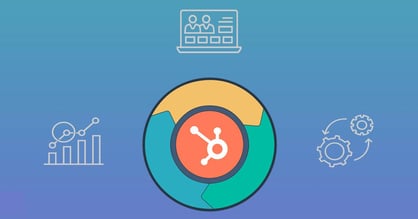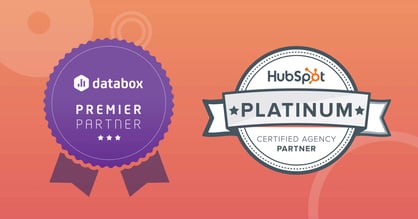Whether you are a brand or an agency, have a transactional or consultative sales model, use a CRM or not, you have likely been using a sales funnel since you began in the industry. Well, if you haven’t already heard, HubSpot killed the sales funnel and replaced it with a wheel– a flywheel. This new methodology flips the funnel on its head and changes our perspective of the buyers’ journey because, in the words of HubSpot CEO Brian Halligan, “word-of-mouth is now the loudest voice in their head.”
The idea of the flywheel has transformed the way that we think about how customers make purchasing decisions. Understanding the structure of the flywheel can help you develop a dependable sales process that will turn MQLs into loyal customers who keep the wheel spinning.
As HubSpot Gold Partners, we use our CRM to maximize sales through both inbound and outbound approaches. However, even if you are not a HubSpot user, the flywheel can help you map out your growth model around how your potential customers are buying today.
A literal flywheel is a disc that sits on an axis and produces energy as force is exerted upon it so that it keeps itself spinning. For HubSpot, the flywheel represents a circular process by which marketing feeds sales, sales feeds customers, and customers feed growth. While the traditional sales funnel ends once the deal is closed, the flywheel’s biggest source of energy is happy customers that become free promoters for the brand.
Here is how each stage works:
Attract – Use content to spark meaningful conversations with the right decision-makers
Engage – Build lasting relationships by becoming a source of thought leadership that focuses on solutions
Delight – Provide an outstanding, seamless experience that prompts your customers to spread the word
In the old days, salespeople put most of their focus on the Engage stage because they knew the most information about the product or service. But, the rise of technology allowed buyers to gain access to the same information and take control of the conversation. With this shift, companies needed to put more force on the Attract stage by creating better content, gauging reaction, and personalizing their message.
Nowadays, it’s all about the Delight stage by creating an exceptional customer experience. There’s a reason that people gravitate to Uber instead of Taxis, Spotify instead of MP3s, and Netflix instead of theaters. The experience those tools provide is fast, frictionless, and lightweight. And how did you find out about any of those brands? Most likely, someone told you about them.
While the traditional funnel primarily applies to sales and marketing, the flywheel must be incorporated across your organization -- from marketers to sales specialists to service providers. You can also use the flywheel as a lens to approach each area individually. As a marketer, you may look for opportunities to create content for prospects or customers at each stage in the wheel. As a service provider, you find ways to improve the customer experience and feed new offerings to the marketing and sales teams. And as a sales specialist, you can use the flywheel to develop both an inbound and outbound sales approach to get new customers.
When it comes to sales, here’s what our flywheel approach looks like for clients:
Attract - We build audiences of the right decision makers at the right companies so that our clients’ marketing teams are able to reach their full market potential when sharing content.
Engage - Using a very defined sales cadence, we conduct multi-touch outreach via phone calls and emails to reach decision makers at the right time. Along the way, we collect intel and reaction to content so that we can learn more about the market and develop messaging that speaks to their pain points.
Delight - We book meetings with qualified leads and ensure that the hand-off between the prospects and our clients is seamless and straightforward. Throughout the process, we look for opportunities to take more weight off the sales teams’ shoulders so they can focus on what they do best -- closing deals.
In his keynote at INBOUND, Halligan introduced the flywheel and assigned homework to his attendees, which I encourage you to do with your team.
A few years back, MarketLauncher experienced a 20% spike in growth with over 30% of new customers coming from people we already knew. That included former client contacts who had moved to new companies and brought us along with them, current clients who shared their positive experiences with colleagues, and friends and followers who spread the word. We call these people our FANs (Former Account, New Success).
We realized early on that, while providing a great customer experience is essential, so is proactively nurturing and developing that FAN base to get the most sales opportunity possible. The following year, we targeted our campaigns directly to our FANs and saw new business spike again by 10%. We were ready to bring in the big dogs.
We assigned a dedicated business development manager to focus on FAN outreach, including targeted content and personalized messaging. This time, our revenue jumped 34% with more than half coming from our FANs. HubSpot’s analytics tools have given us full visibility into our progress and automated the process to give us more time for sales activity.
It’s not enough to just have an active FAN base. After years of perfecting our own reengagement strategy, we’ve begun helping our clients develop nurturing strategies for their FANs.
The following three elements can systematically work to help you get the most from your customers and followers of your brand:
Identify all of the potential stakeholders for each of your clients and keep track of their activity on socials and on your CRM. Take note when they are reacting to content, moving to a new company, getting a promotion, or experiencing a life-changing event.
Reach out with thought leadership content on a regular basis to stay top-of-mind. That can be in the form of emails, newsletters, downloadable resources, videos, and more. (This is all part of the one way dialogue we started talking about in 2015.) Then, monitor what your audience is reacting to in order to gauge their motivations and interests.
Using insights from content reaction and social media activity, periodically reach out to your FANs when you have a new story to tell or when you notice something in their life has changed. Always approach the conversation with a solution to one of their challenges. The goal is to transition them from a passive consumer of your content into someone who is ready for a serious conversation.
While Halligan focuses on the Delight stage of the wheel making the customer experience better, it takes deliberate action to keep your happy customers communicating about your brand. The flywheel approach helps us visualize our efforts as a force that keeps the momentum going. When coupled with a proven sales framework and reengagement strategy, it can only spin faster.
At MarketLauncher, being a HubSpot Gold Partner means we can manage the entire flywheel ecosystem from one platform and bridge the gap between marketing, sales, and service both for ourselves and our clients. Once you’ve mapped out your flywheel, let’s talk about how you can maximize your market potential and grow your customer base through an inbound and outbound sales strategy.




